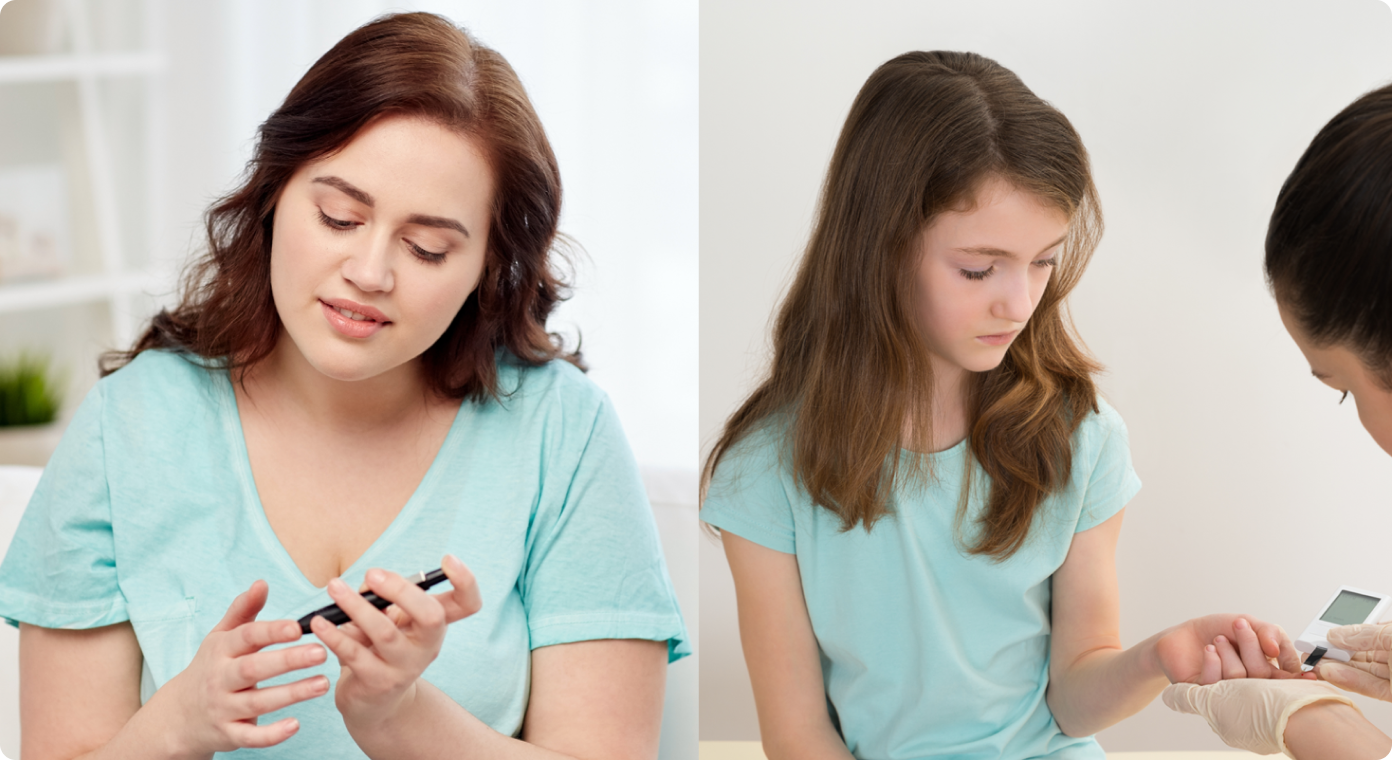Table of contents
What is type 2 diabetes?
What is type 2 diabetes?
A chronic condition, type 2 diabetes, occurs when your blood sugar levels spike beyond normal values. This makes the body incapable of processing glucose as it normally should provide cells with energy.
In type 2 diabetes, your body cannot use insulin normally and/or the pancreas, an organ found near the stomach, cannot produce enough insulin. Insulin is a key hormone that enables glucose to function effectively as the body's main source of energy.
Unlike other types of diabetes, type 2 diabetes is more closely associated with an unhealthy diet, lack of activity, smoking, alcohol intake, and other preventable risk factors.
Some people have prediabetes before developing type 2 diabetes. Pregnant women may develop gestational diabetes, potentially leading to type 2 diabetes.
Over time, high blood sugar levels can damage the immune, circulatory, and nervous systems. Type 2 diabetes is not curable. However, with dietary and lifestyle changes, and/or medication, the condition is highly manageable in many individuals.
Managing diabetes doesn't mean only eating healthy, though. You have to pay attention to the glycemic index of your food, which determines how quickly it raises your blood sugar level. Exercise and healthy lifestyle choices are also crucial.
Historically, type 2 diabetes has affected people over the age of 45, with men and women having roughly the same risk. However, type 2 diabetes is becoming increasingly common among adolescents and young adults.
This fuels concerns that type 2 diabetes is one of the major epidemics of the 21st century.
Signs and symptoms
Because type 2 diabetes symptoms develop slowly, many people live with the condition for years without realizing it. According to the American Diabetes Association (ADA), over 8 million people in the US live with undiagnosed diabetes.
Here are the most common signs and symptoms of diabetes:
Frequent need to urinate, which some people experience, especially at night
This occurs because the kidneys try to filter out excess sugar from the blood.
Increased thirst
Frequent urination causes the body to lose water and dehydrate.
Always feeling hungry
Because the body doesn't get enough energy from food.
Tiredness
The result of glucose remaining in the bloodstream rather than moving into cells.
Blurry vision in one or both eyes
The sugar in the bloodstream can damage the tiny blood vessels in the eye, causing vision problems that come and go.
Repeated infections and wounds or sores that don't heal
Extra glucose in the blood can cause damage to blood vessels in other parts of the body as well as nerves, disrupt blood circulation, and interfere with the natural healing process.
Unintended weight loss
This occurs if the body, deprived of glucose, begins to burn fat and muscle for energy.
Yeast infections and itching/burning/soreness
High levels of glucose in the blood can promote yeast growth, leading to recurrent infections. Persistent itching, burning, or soreness should prompt a medical evaluation for possible diabetes.
The early signs and symptoms may be subtle enough to be disregarded. But being aware of them makes spotting type 2 diabetes early easier.

Type 2 diabetes vs. type 1 diabetes
People with type 2 diabetes don't normally respond to insulin. It's only in the later stages of the condition that the pancreas may not make enough insulin. By contrast, those with type 1 diabetes don't produce insulin at all and need to self-inject themselves with this hormone.
Both type 1 and type 2 diabetes are chronic diseases leading to high blood sugar levels. They are similar in that they affect glucose regulation in the body and its ability to turn food into energy.
However, type 1 diabetes is considered a genetic autoimmune disease in which the immune system mistakenly attacks pancreatic beta cells, which produce insulin.
This may occur because of genetic and environmental factors, but the exact cause is not known. It was previously called juvenile diabetes because it often develops in childhood or adolescence, with symptoms developing quickly rather than slowly, as is the case with type 2 diabetes.
Type 2 diabetes is more often associated with preventable risk factors, even though genetic and environmental factors also contribute to its onset. Some research suggests that type 2 diabetes may also be an autoimmune disease and that insulin resistance can be the result of the immune system mistakenly attacking cells.
Causes and risk factors
The body needs insulin to sustain functions that are essential for life. The main role of insulin is to allow muscle, fat, and liver cells to absorb blood glucose for energy. As we have seen, type 2 diabetes occurs when the cells become less sensitive to insulin.
This, in turn, makes the pancreas work harder to produce more insulin. In some people with type 2 diabetes, the strain on the pancreas makes it produce less and less insulin.
Studies found that type 2 diabetes results mostly from the interaction of genetic, environmental, and other risk factors. Over 150 DNA variations that change gene activity or expression have been linked to a higher risk of developing the condition.
The main risk factors for type 2 diabetes are:
Having prediabetes
People with prediabetes have higher than normal blood sugar levels of 5.7 to 6.4% as measured by the A1C test or 100 to 125 mg/dL as measured by the fasting blood sugar test.
Being overweight and/or having a high waist circumference
A waist circumference above 40' in men and 35' in women increases the risk for insulin resistance.
Being 45 years or older
Even though adolescents and young adults can get diabetes, age continues to be a major risk factor for diabetes.
Family history of type 2 diabetes
Having a sibling or parent with diabetes increases your risk.
Sedentary lifestyle
Being physically inactive further drives the risk for diabetes whether or not it occurs in conjunction with having a higher-than-normal body mass index (BMI).
Race and ethnicity
African Americans, Hispanics, Asian Americans, and American Indians have a higher risk.
Gestational diabetes
Women who develop gestational diabetes during their pregnancy are more likely to get the condition.
Giving birth to a baby over 9 pounds
This is a risk factor whether or not you develop gestational diabetes during pregnancy.
Polycystic ovary syndrome (PCOS)
Women with this condition produce too many male sex hormones. PCOS is associated with higher levels of circulating insulin and may increase the risk for type 2 diabetes.
Having other diseases
Having a history of stroke or heart disease, suffering from non-alcoholic fatty liver disease, or the skin condition acanthosis nigricans.
Bad cholesterol
Low levels of the good cholesterol HDL or high triglycerides are associated with a higher risk.
Having depression
Research suggests that a history of depression increases the risk of type 2 diabetes in young adults.
High blood pressure
A Korean study found that hypertension is an independent risk factor for the condition.
Low Vitamin D levels
Vitamin D deficiency is correlated with a higher risk of diabetes.
Diagnosis and treatment
Type 2 diabetes is diagnosed through blood tests. The condition can be diagnosed without obvious symptoms and is often spotted during routine tests.
The following blood tests are used to diagnose type 2 diabetes:
- A1C Test - this test measures your average blood sugar level during the last two to three months. More specifically, it looks at the level of glycated hemoglobin in the blood. A reading of 6.5% or higher indicates diabetes and often calls for a second confirmation test. A reading between 5.7% to 6.4% can also be a warning sign as it indicates prediabetes.
- Fasting blood sugar test - another common type 2 diabetes test that requires a sample taken after overnight fasting. This test measures the milligrams of sugar per deciliter in the blood. A result over 126 mg/dL indicates diabetes. A result over 100 mg/dL but lower than 125 mg/dL indicates prediabetes.
- Random blood sugar test - this test can also be carried out as a random blood sugar test regardless of when you last ate. A result over 200 mg/dL indicates type 2 diabetes.
- Oral glucose tolerance test - carried out during pregnancy, this test involves an overnight fast and then drinking a sugary drink. The drink may be administered at set intervals. The results of this test are similar to those of a random blood sugar test, with a result over 200 mg/dL suggesting diabetes.
Lifestyle changes
Type 2 diabetes treatment usually begins with lifestyle changes. These include healthy eating, exercising regularly, losing weight, and managing stress.
Eating healthy
Having type 2 diabetes doesn't have to mean following a specific diet. However, it does mean eating more healthy foods and may require changing some of your eating habits. Here are the key recommendations doctors often make:
- Eat fewer processed foods, refined grains, and sweets.
- Eat fewer calories.
- Eat fewer starchy vegetables like russet potatoes.
- Cut down on sugar drinks or give them up altogether.
- Cook using healthy oils like olive oil.
- Eat low-fat meat, dairy, and fish in moderation.
- Eat more whole grains, fruits, nonstarchy vegs, and high-fiber foods in general.
- Reduce portion sizes and schedule regular meals.
- Give up on unhealthy snacks.
- Keep an eye on food's glycemic index and your carb intake to maintain stable blood sugar levels.

Exercise regularly
Thirty minutes of aerobic exercise a day or at least 150 minutes a week helps to better manage type 2 diabetes and possibly slow its progression.
Resistance training that increases your balance and strength, such as yoga and weightlifting, can also be beneficial.
Also crucial is to avoid long periods of inactivity, such as sitting on the couch for longer than 30 minutes at a time.
Weight loss
Losing as little as 5% of your body weight helps you better control blood sugar levels and cholesterol and is associated with a better prognosis.
Eating healthy and starting to exercise may naturally help you shed some excess weight.
Depending on your blood sugar levels, your doctor may also prescribe medication. Type 2 diabetes medication is not a replacement for dietary and lifestyle changes - it is still necessary to better manage the condition.
Prevention
As we've seen, type 2 diabetes has many preventable risk factors. Whether you have prediabetes or worried that you may develop type 2 diabetes, there's a lot you can do to prevent the condition.
For instance, eat healthy following the tips and recommendations we shared with you above. Also, cutting sugar and refined carbs is especially important.
Exercise daily for 30 minutes for a total of at least 150 every week.
Here are more tips:
- Try healthily losing weight if you have a higher-than-normal BMI.
- Use water as your main beverage and drink it regularly. Drinking more water can improve blood sugar control.
- Quit smoking.
- Drink alcohol in moderation.
- Manage stress better through meditation and other relaxation techniques. Consider also seeing a therapist.
- Avoid sedentary habits that keep you sitting for more than 30 minutes at a time.
- Take a vitamin D supplement.
- Drink coffee and caffeine tea as these have been linked to a lower risk of diabetes.
In the end, type 2 diabetes doesn't have to be a sentence to ill health and handfuls of pills. It can be an opportunity to live more healthily and become more active. Start with a personalized meal plan and add physical exercise to your everyday life.
Take a quiz and get your diabetes-friendly meal plan today!

Related articles

What is diabetes?
6 min read•January 2, 2024

What is type 1 diabetes?
10 min read•January 8, 2024

What is prediabetes?
6 min read•January 26, 2024

What is gestational diabetes?
7 min read•December 10, 2023
Resources
Blog